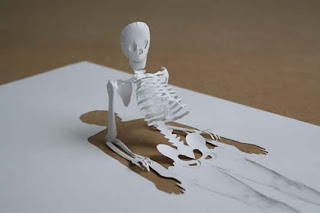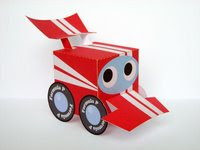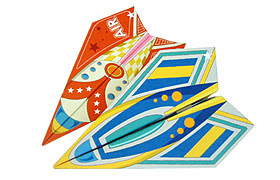There is a strong link between crafts activities and skill development among children of all ages. I am also a craft teacher and noticed it very often that many kind of crafts help in skill development which as a results produce good learning outcome in their other subject areas. Let's have a look at some research based studies and reports in this connection:
"The Academic Value of Hands-on Craft Projects in Elementary Schools"
Conducted in 2001 by ROCKMAN ET AL, an independent educational research and consulting company, the study revealed the following key findings:
* Student learning improves when classroom lessons incorporate hands-on craft activities.
* Students develop greater curiosity about the subject matter when craft projects are included.
* Student behavior and socialization skills improve when crafts are undertaken.'
Teachers regularly use craft projects to teach the core subjects and link the projects to state and national curriculum standards.
Teachers say learning through craft projects accommodates students with different learning styles.
Focus Group Research
In 2005 teachers from two different U.S. cities, Paramus, NJ and Cleveland, OH, participated in two focus group studies. Key findings of these studies include:
Crafts can enhance the lesson and the learning process and in many cases are vital to the learning process.
Crafts can be a break from some of the serious and boring academic activities
Through the use of crafts, teachers gain a better understanding of the child’s thought process
Teachers agree the average amount of time for a craft activity in the classroom is thirty minutes.
During the fall of 2001, the Hobby Industry Association (HIA) contracted [with] an independent educational research and consulting company, to study the impact of hands-on craft projects as an instructional method within the core curriculum. Additionally, they wished to determine ways this teaching technique links to state and national education standards.
As the only large-scale study of its kind, and one of the first efforts to investigate the area of hands-on projects and academic learning, this study found that a significant number of teachers use hands-on projects linked to core curriculum content to advance standards-based learning. Teachers said hands-on projects enhance the instructional process and help students learn both basic information and more complex ideas. Additionally, students develop important learning skills and the abilities to articulate complex ideas, to use appropriate and sophisticated terminology, and to integrate the ideas they have learned into their continuing learning efforts. This belief was confirmed by student data evidence collected in this study.
KEY FINDINGS
Student learning improves when classroom lessons incorporate hands-on craft projects.
Students who spent a greater proportion of their classroom learning time engaged in hands-on projects scored significantly higher on writing and drawing knowledge application tasks. In classes that spent almost half of instructional time on hands-on projects (48%), students scored an average of 83 out of a possible 100 on the knowledge application task. Comparatively, students whose classes devoted a low percentage of class time to craft projects (11.8%) scored an average of 75. The creativity and level of detail students demonstrated on the application tasks also indicated that the hands-on projects left many students with vivid and lasting understanding of both facts and concepts.
Teachers regularly use hands-on craft projects to teach the core subjects and link the projects to state and national curriculum standards.
Almost three-fourths (72%) of the participating teachers indicated that they explicitly and intentionally link their instructional units involving hands-on projects to state or national standards. In addition, writing, research and presentation skills are typically incorporated into the projects.
Students develop greater curiosity about the subject matter when hands-on craft projects are included.
Ninety-six percent (96%) of teachers agreed that students exhibit greater curiosity about the learning unit when hands-on projects are included in the instructional approach. Teachers also reported significant differences in learning behaviors when students are involved in hands-on projects. They reported increases in student motivation, willingness to ask questions and volunteer information, enthusiasm, and attention to assigned tasks.
Teachers say learning through hands-on craft projects accommodates students with different learning styles.
While 46% of teachers viewed hands-on projects as an effective learning technique for all students, 54% said this approach is particularly well suited for students who learned more effectively in non-traditional approaches, such as visual or kinesthetic learners, slow readers or writers, or non-native English speakers.
Student behavior and socialization skills improve when hands-on craft projects are undertaken.
Teachers reported enhanced cooperation, responsibility, dedication, confidence, and time management skills when students participated in hands-on projects. Eighty-five percent (85%) of the teachers said students work cooperatively on handcrafted projects, while only 50% of the teachers said they do so in non hands-on projects.
CONCLUSIONThe study concludes that hands-on craft projects are an effective means of teaching a standards-based curriculum and that students develop both a greater appreciation for and understanding of what they are learning.
Hands-on projects appear to function as learning anchors that organize and integrate various classroom-learning activities.
By making the learning experience concrete, the dynamics of these learning anchors inspire students to enjoy learning, accomplish goals, take pride in their achievements, and persevere in their learning.
For the full 45 page PDF report:
Download for FREE














































